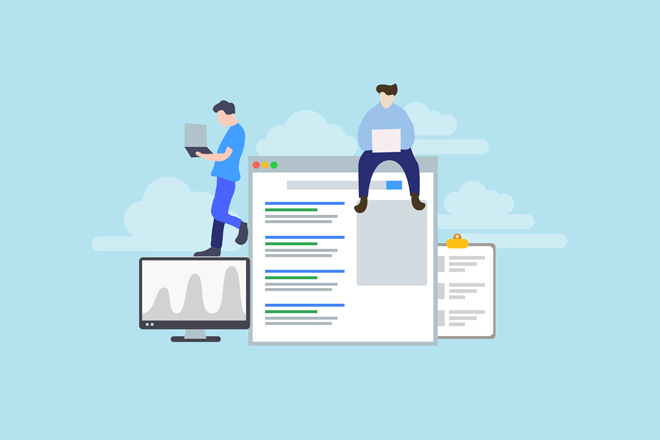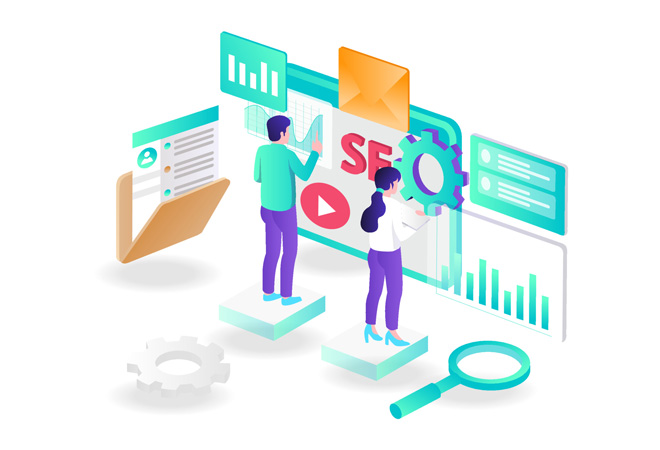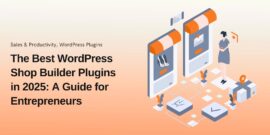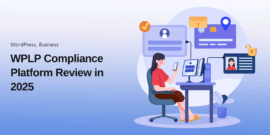
10 Tips to Maximizing Business Growth Through Effective Website Design
Every website owner wants to build a website that meets both its user's and business needs. That's the magic of good website design- it's the bridge between your audience's needs and your brand's aspirations.
But hold on a sec! Don't fall into the trap of assuming your website design is already top-notch. Crafting a standout brand presence takes more than just a pretty interface.
It's about diving deep into the nuances, understanding what truly resonates with your audience, and wielding the right tools to bring your vision to life.
With proper planning and clear goals, you can create a web design that matches your brand identity and what the user seeks on the website.
So, let's study the five most essential elements that make a good website design.
What’s the Purpose of Your Website?
Before even beginning to build your website design, you must have a clear intention about what you want to achieve with it.
- What defines your business?
- How can you present that definition with your design?
- What elements are non-negotiable for you?
- What type of users do you want to engage with through your website?
These are some basic questions you must have answered before starting your website design.
Whether you are trying to convert your basic design to a functional website from Figma to WordPress or building a website from scratch on one powerful platform, you must be clear with the basics.
The most important aspect of your design must be “user intent,” which means understanding your audience and what they need when they search for you.
Thus, you must work on product personas and ideal customer profiles before building your website. When your target users lead you, you can create a website that will serve its true purpose.
Each aspect of your page, from the homepage and service pages to CTA, must reflect user intent and clearly define what your product service is about.
Great UI/UX
User experience (UX) and user interface (UI) are two significant parts of a great website design. These two things can influence how your users interact or engage with your site. UI is something that your users will see, and UX is what and how they experience and engage with your website.
So, when designing a website, these two aspects must be an inseparable part of your website design plan. A clean and considered design with interesting elements and features makes for an ideal UI design. Make sure to include elements like videos, media, and animation, however, in a way that does not overwhelm the user experience.
Another thing that you need to keep in mind is creating a seamless user experience.
- Is your site easily accessible?
- Are users able to navigate through pages?
- Are they able to interact with every page of your website?
So, you must build a design that is intuitive, easy to navigate, and accessible without any limitations, and let the users do what they actually came for.
Quality Content & SEO
You might think that content and SEO are not as important as other aspects for creating a good website design, but a website without quality content will fail to serve its purpose. Do you know why? Because
- Quality content engages your audience and keeps them on your site longer.
- Relevant keywords in content improve visibility to the target audience.
- Regularly updated content signals to search engines that your site is active and valuable.
- High-quality content establishes authority and builds trust with users.
- SEO-friendly structure enhances website usability and navigation.
So, your website must have user-centric content that explains what the users want to read when they land on the website.
Content created for what your users search for is based on SEO's role. You can explore and use interesting topics, structure content, and format it in a way that is reachable to your audience. Using just the right keywords and relevant links on the site will not only help present quality content but also enhance the whole structure of the website.
Responsive Design
Just creating a website design won't do anything good for you. A design that is not optimized for multi-device use will lack its overall purpose. Today, most users are on mobile devices, which take up over half of the internet traffic. Let’s understand how responsiveness is equally important when designing a website:
- Enhances brand reputation by providing a seamless browsing experience
- Increases conversion rates by catering to users' preferred devices
- Saves time and resources by eliminating the need for separate mobile versions
- Boosts SEO ranking as search engines prioritize mobile-friendly sites
So, you must make sure that your website is a multi-decide response., i.e., it should be optimized for all kinds of devices like desktop, mobile, and tabs and can be navigated through different screen sizes.
You can always test your website design in different screen sizes and make sure it's easily navigated and interacted well by users with all kinds of devices.
As internet browsing through smartphones and tablets increases, responsive design has become an essential feature of effective website design.
Responsive websites automatically adjust to the screen size of the device they are being viewed on, ensuring a smooth experience for all users, regardless of how they access the site.
Website Performance
Creating a great website design is just the beginning; maintaining optimal performance is equally crucial. Even the most visually stunning website won't be effective if it's slow to load or prone to glitches. Here’s what happens if your website performance is not upto the mark:
High bounce rates as visitors leave due to slow loading times
- Decreased user engagement and time spent on site
- Negative impact on search engine rankings
- Loss of potential customers and revenue
- Damage to brand reputation and credibility
- Higher likelihood of security vulnerabilities and breaches
That's where Seahawk's site optimization service comes to the rescue.
Partnering with Seahawk, you can ensure that your website not only looks great but also performs flawlessly. With regular monitoring, updates, security checks, and site speed optimizations, Seahawk helps keep your website running smoothly and efficiently. Additionally, Seahawk offers white-label WordPress services, providing expert support and customization options for WordPress-based websites.
Prioritizing website performance and optimization is essential for creating a good website design that delivers a seamless user experience and achieves your business goals.
In today's digital age, a website is more than just a digital footprint; It's a powerful tool for business growth.
It has been proven that a well-designed website can elevate your brand, attract the right target audience, and significantly improve business performance.
This article will go in-depth into practical tips and advice for maximizing business growth through effective website design, tailored for business owners looking to establish themselves within the industry.
Understanding Your Target Audience: The First Step to Effective Website Design
Before getting into the specifics of website design, it's important to deeply understand your target audience. Your website should reflect their needs, preferences, and pain points.
Conduct thorough market research to gain insight into your target audience. This includes their browsing habits, content preferences, and devices they use.
This knowledge will become the foundation for designing a website that truly resonates with your target audience.
The role of aesthetics and functionality in website design
The intersection of aesthetics and functionality is the ideal point for effective website design. This is where visual appeal meets user experience, creating a harmonious balance that not only attracts visitors but also keeps them engaged.
In this section, we'll explore how you can achieve this balance, ensuring your website functions as a powerful tool for business growth.
Balancing visual appeal and usability
A visually appealing website is important, but not at the expense of usability. Your website design should promote an effortless user experience with intuitive navigation and fast loading times.
High-quality images, a consistent color scheme, and easy-to-read fonts are essential elements that contribute to the aesthetics and functionality of your site.
TOP-5 design principles
To achieve this balance, consider the following list of design principles:
- Simplicity: Keep your design clean and uncluttered. This makes it easier for users to focus on your content and value proposition.
- Hierarchy: Use visual hierarchy to direct visitors' attention to the most important elements on your page.
- Consistency: Make sure design elements remain consistent across all pages for a consistent user experience.
- Accessibility: Design your website with accessibility in mind so that everyone, including people with disabilities, can easily navigate and interact with the site.
- Mobile Responsiveness: With the increasing use of mobile devices to access the web, make sure your design looks great and performs well on all screen sizes.
Enhancing user engagement through content strategy
Content is the backbone of your website. Not only does it play an important role in SEO, but it also helps engage and retain visitors.
Implement a content strategy that includes valuable, relevant, and consistent content that addresses the needs and interests of your target audience. Use headings, bullets, and short paragraphs to make your content easily scannable.
Increase visibility with SEO
To truly maximize your website's potential, it is essential to incorporate a solid SEO strategy. SEO, or search engine optimization, is the art and science of improving your website's visibility in search engine results pages.
When done correctly, SEO can significantly increase traffic to your site, attract high-quality leads, and ultimately contribute to business growth. Let’s get into the key components of an effective SEO strategy.
Keyword Optimization to Attract the Right Audience: The Keys
Keyword optimization is the core of SEO. This involves identifying and incorporating the keywords and phrases your target customers use when searching for your products or services. Some key strategies for effective keyword optimization include:
- Use keyword research tools: Tools like Google Keyword Planner, SEMrush, and Ahrefs can help you find relevant keywords with high search volume and low competition.
- Focus on long-tail keywords: These are long, specific keyword phrases that visitors are more likely to use when they are closer to the point of purchase or when using voice search.
- Integrate keywords naturally: Make sure your content reads naturally and doesn't look forced or padded by keywords, which can harm user experience and harm SEO.
Building quality backlinks
Backlinks, or incoming links to your website from other websites, are an important factor in SEO. This sends a signal to search engines that others endorse your content, which can improve your site's ranking. Here are some effective ways to build quality backlinks:
- Guest Blogging: Write articles for trusted sites in your industry to get links back to your site.
- Create shareable content: High-quality, informative, and engaging content is more likely to be shared and linked to by others.
- Participate in industry forums and discussions: Participate in online communities relevant to your field and, where appropriate, include a link to your website in your signature or profile.
- Leverage Social Media: Promote your content on social media platforms to increase its visibility and increase your chances of receiving backlinks.
Case Study: Effective Website Design by 1win
While discussing effective website design, it is important to highlight the success story of 1win , a leading bookmaker.
1win’s website design shows how strategic design elements can have a huge impact on user engagement and business growth. Through a user-friendly interface, responsive design, and compelling content strategy, 1win has been able to stand out in the highly competitive online betting industry.
Their website is not simply one of a variety of platforms to place bets on, but offers an immersive experience that meets the needs and preferences of their target audience.
Continuous testing and improvement
The importance of A/B testing
A/B testing allows you to compare two versions of a webpage to see which performs better.
By regularly testing elements like CTA buttons, headlines, and images, you can gain valuable insight into what best resonates with your target audience, which can improve engagement and conversion rates.
Collect and act on user feedback
User feedback is very important for continuous improvement. Use surveys, feedback forms, and usability testing to gain insights from your target audience.
Based on this feedback, make any necessary adjustments to your website to ensure it matches your users' needs and preferences.
Path to business growth through website design
Therefore, effective website design is a dynamic and ongoing process that plays an important role in business growth.
By understanding your target audience, balancing aesthetics and functionality, executing a solid content and SEO strategy, and continually testing and improving, you can create a website that not only ranks highly in search engines but truly resonates with your target audience.
You can make it. Remember, your website is often the first point of contact with potential customers and is a key element in the success of your business.
Are you ready to transform your website?
If you're ready to take your business to the next level with a website that promotes growth, start reevaluating your website design and content today to focus on user experience and leverage the latest SEO strategies. Remember, in the digital world, your website is your most powerful asset.
Without a proper online presence, your business is as good as non-existent. Your social media serve as the foundation of your business's digital footprint, but a website is key to maximizing its growth.
However, it is no longer enough to just have a website. It needs to be effective and efficient, both in terms of design and usability.
From the layout to the content, every detail of your website has an impact on the perception of your business by potential customers, partners, and investors.
Way to Maximizing Business Growth?!
All this means that if your website isn't up to par, you can be sure it is hurting rather than helping the growth of your business. But how exactly does your website design affect your business's growth?
Here's how…
User Experience and Engagement
The first step in gaining customers is getting them onto your website – but the second step is making sure they stay. A well-designed website will make the user experience smooth, intuitive, and enjoyable.
This includes factors such as fast loading times, easy navigation, and a mobile-friendly interface.
Even if you're investing in websites that already have a well-structured design, it's important to look out for any potential issues.
For instance, if your website takes longer than 3 seconds to load or has too many popups and ads, this could be enough of an inconvenience that the user chooses not to pursue further engagement with your business.
Accessibility
Accessibility is often brought up in relation to web design when talking about making sure that all users, regardless of physical ability or disability, can access and use a website. But the truth is that everyone benefits from accessibility.
Good web design should make it easy for people to find what they're looking for, understand the content, and use all of the features available on a page.
This means that if your website isn't accessible to everyone, you could be losing out on potential customers or investors who are unable to engage with your site properly.
Compatibility
You don't want to push some of your visitors away with a website that doesn't work properly on certain devices.
Today, most websites are built on frameworks that are separate from the underlying operating system, meaning that a website should work on any platform.
The same goes for responsible design principles. Instead of adjusting your front end for specific screen sizes, you should instead aim to make your website adapt to any device.
This will ensure that regardless of the device being used, it looks and works properly for all users.
SEO and Performance Optimization
Search engine optimization (SEO) is a key part of maximizing your business's growth as it allows your website to rank higher in search engine results pages.
This means that more potential customers will be able to find and visit your website, increasing the chances of them becoming paying customers.
In order for SEO efforts to pay off, you need a well-designed website with optimized performance factors, such as page speed and meta tags.
Search engines like Google take these into consideration when deciding which websites should appear at the top of their SERPs – so make sure yours is up to scratch.
Broken Links
Broken links are among the most common issues that can lead to a poor user experience and negatively impact SEO.
When someone clicks on a broken link, they will either be taken to an error page or simply nothing at all – both of which don't make for great engagement with your website.
Make sure you regularly check for any broken links and remove them as soon as possible in order to keep people engaged with your site longer.
This could involve working through each page manually or using automated tools such as Google Search Console's URL inspection tool to identify any potential problems quickly and easily.
Content
Content is the backbone of any website, so it’s crucial to make it clear and engaging. This means creating informative, helpful, and interesting pieces of content that address user needs, such as blog posts, videos, or infographics.
Your web design should make it accessible for all users so they can easily find what they are looking for on each page.
If you want to optimize SEO further, then ensure all your pages have unique meta descriptions with keywords related to the topic at hand. This will help search engines understand your site better and rank it higher in SERPs.
Branding and Visuals
Your website's design should reflect your brand identity, which is why visuals are so important.
Your logo and color scheme should be consistent across all pages to create a sense of continuity for users. This will help build trust in the minds of potential customers.
After all, they want to know what kind of business they can expect when buying from you or investing their time into interacting with your site.
In addition to this, make sure that any imagery used on the site looks professional and high-quality.
Poorly shot photos or stock images might not be enough anymore as web design trends have shifted towards custom illustrations instead, making sure your website stands out and looks unique.
To Sum Up
Your website design can be a powerful tool for building a loyal customer base, engagement, and even leads for your business. Each element used on your website must be designed in a way that it can cater to both your and your audience's needs.
All websites are unique and serve different purposes; however, the foundation of each website is laid with the same purpose: serving its users and growing the business. So, keep the above five characteristics in mind while building a great website design and creation that stands out.
By paying attention to the details of your website design, you can ensure that it serves as a powerful tool for business growth.
From optimizing user experience and SEO performance to ensuring accessibility and creating an effective brand image – there are many factors that come into play when designing a successful website.
With this in mind, make sure you're taking all these elements into consideration if you want to maximize your business's potential through effective web design.
And remember that it's never too late to make changes and improvements – so don't be afraid to experiment and keep your website up-to-date with the latest trends.





